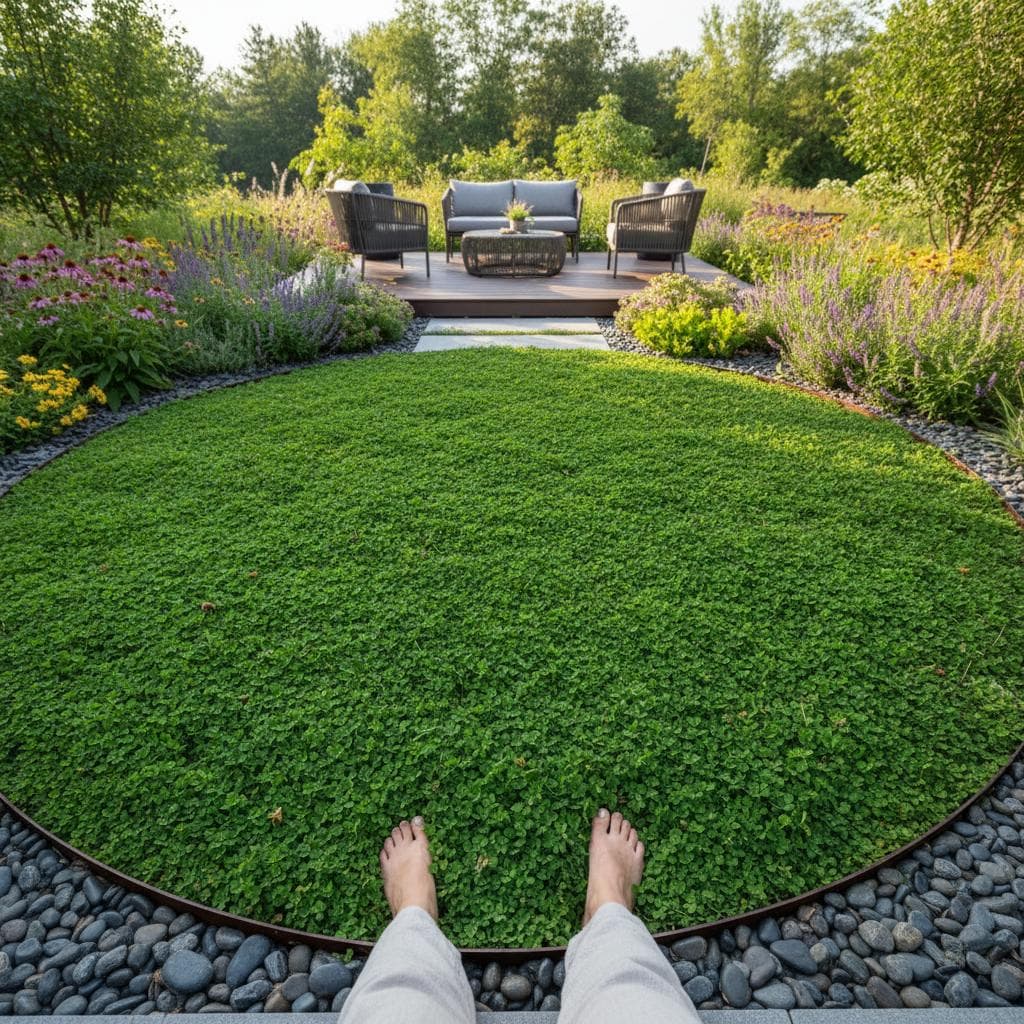Why Clover Lawns Represent the Ideal Low-Maintenance Option
Homeowners often seek a verdant yard that requires little upkeep while delivering aesthetic appeal. Clover lawns achieve this equilibrium by remaining vibrant during drought conditions, demanding infrequent mowing, and suppressing weeds without regular fertilizer applications.
Once viewed merely as an interloper in grass lawns, clover now serves as the core element of contemporary, hardy landscapes. It fosters pollinator habitats and minimizes labor-intensive tasks. The outcome yields a plush, cooling surface that excels in areas where traditional grass falters.
1. Select the Appropriate Clover Variety
The choice of clover species determines the lawn's enduring performance. Microclover, a fine-leaved form of white clover, integrates seamlessly with existing turf grasses to produce a uniform, polished appearance. Pure white clover establishes a thick mat that deters weed invasion and provides a gentle texture for barefoot walking.
Landscape designers frequently note that microclover delivers the elegance of a groomed lawn with reduced mowing demands. This type maintains a compact height, converts atmospheric nitrogen into soil nutrients, and rebounds swiftly from heavy use.
In expansive areas, combining white clover with dwarf grasses yields a meadow-inspired vista. Such blends regulate water retention effectively and introduce varied textures across seasons.
Visual callout: Delicate white flowers dot a sun-drenched expanse of clover.
2. Prepare the Site and Establish Your Clover Lawn
Proper site preparation ensures clover's successful integration and longevity. Begin by testing soil pH, aiming for a range of 6.0 to 7.0, as clover thrives in slightly neutral conditions. Amend acidic soils with lime to optimize nutrient uptake without synthetic additives.
Clear the area of existing vegetation by mowing low and applying a natural smothering mulch, such as cardboard topped with compost, for two to four weeks. This method eliminates competition gently. Till lightly to a depth of two inches, then rake smooth to create an even seedbed.
Broadcast clover seeds at a rate of two to four ounces per 1,000 square feet in early spring or fall, when soil temperatures hover between 50 and 85 degrees Fahrenheit. Lightly rake seeds into the soil and water gently to settle them. Germination occurs within seven to fourteen days, with full coverage developing over one growing season.
For overseeding into existing lawns, mow short, remove clippings, and spread seeds evenly before watering consistently for the first few weeks. This approach allows gradual transition without full renovation.
Visual callout: Freshly seeded patches of clover emerge amid prepared earth.
3. Reduce Mowing Frequency for Greater Enjoyment
Clover's deliberate, uniform growth pattern limits mowing to three or four sessions annually. Maintain a height of three to four inches to preserve a dense, padded quality that inhibits weed establishment. This consistent level also promotes a neat profile without additional bordering or clipping.
Unlike grass, clover avoids uneven patches post-mowing due to its self-moderating habit. Many owners forgo mowing entirely, permitting small flowers to form a inviting, pollinator-friendly meadow.
Groundskeepers observe that infrequent mowing prevents soil compaction and enhances microbial activity. Such vitality improves water infiltration and sustains the lawn's resilience over time.
To mow effectively, use a sharp blade on a high setting and leave clippings on the surface as natural mulch. This practice recycles nutrients and maintains moisture levels.
Visual callout: A lightweight mower passes over a uniform clover field with ease.
4. Minimize Watering and Eliminate Fertilizer Needs
Clover's deep root system accesses water efficiently, reducing irrigation requirements by up to 75 percent compared to grass. In established lawns, supplemental watering suffices during prolonged dry spells exceeding two weeks, applying one inch per session to encourage root depth.
The plant's nitrogen-fixing bacteria convert air into usable soil fertilizer, eliminating the need for chemical inputs. This symbiotic process enriches surrounding plants, creating a self-sustaining ecosystem that supports clover's persistent green hue.
Monitor for drought stress through subtle wilting, then water deeply but infrequently to promote resilience. Mulching around edges with organic matter further conserves moisture and suppresses bare spots.
Horticulturists emphasize that this natural fertility cycle not only saves resources but also prevents runoff pollution, benefiting local waterways.
Visual callout: Dew-kissed clover blades glisten after a light morning watering.
5. Define Transitions and Maintain Edges
Clover's relaxed growth habit benefits from clear delineations to appear purposeful. Install gravel walkways, stone curbs, or slim metal edgings to confine expansion and impart structure.
Integrate clover with ornamental grasses or perennials to ease shifts from lawn to garden areas. Select natives such as little bluestem, echinacea, or rudbeckia, which share clover's drought tolerance and amplify ecological value.
Landscape contractors assert that precise boundaries elevate casual designs to polished standards. Strategic framing keeps the yard visually cohesive across changing seasons.
Inspect edges monthly, trimming as needed with shears to reinforce lines. This simple upkeep preserves the intended layout without extensive labor.
Visual callout: A smooth stone edging frames a vibrant clover patch adjacent to wildflowers.
Experiencing the Benefits of a Clover Lawn Daily
An established clover lawn transforms outdoor interactions. It remains refreshingly cool during warm months and yields under pressure, ideal for play or pet activities. The steady greenery and subtle bloom fragrance infuse spaces with serene, organic allure.
Upkeep evolves into light tasks: trim borders seasonally, overseed thin areas annually, and irrigate sparingly. These efforts yield tangible gains, including lower utility costs and a habitat that nurtures bees, butterflies, and beneficial insects.
Clover lawns demonstrate that sustainable choices enhance rather than compromise landscapes. They integrate effortlessly into routines, fostering enduring vitality and aesthetic satisfaction.

